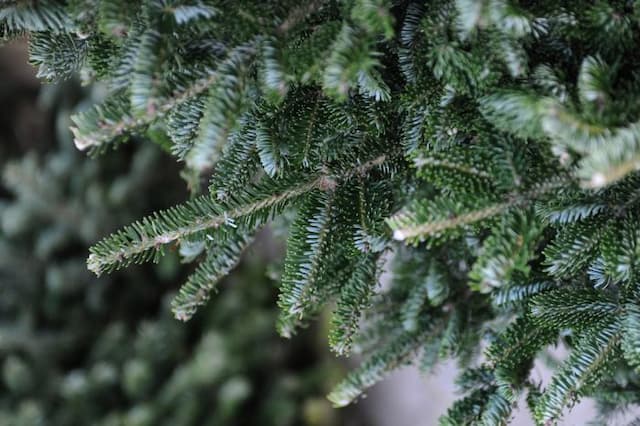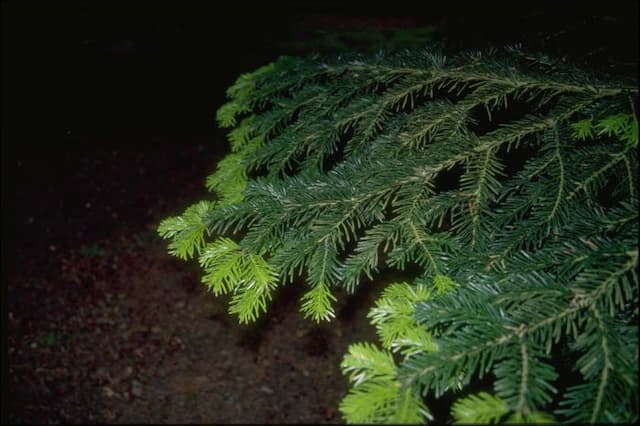Spanish Fir Abies pinsapo 'Glauca'

ABOUT
The Spanish fir 'Glauca', also known as the blue Spanish fir, is a striking conifer renowned for its beautiful foliage and symmetrical form. This evergreen exhibits a pyramidal shape with branches that radiate out from a central trunk in a dense, conical configuration. Its needles are particularly noteworthy, each one slightly curved and roughly one to one and a half inches in length. They grow radially around the twigs, creating a bottlebrush effect that is quite pleasing to the eye. The color of the needles is a distinctive silvery-blue to blue-green, which is where this variety gets the name 'Glauca'. This bluish hue provides a shimmering, metallic effect, lending the plant an eye-catching and somewhat unique appearance among evergreens. In addition, resin blisters can be found on the bark of the trunk, adding to its character and texture. During the season when it produces cones, the Spanish fir 'Glauca' boasts upright cylindrical cones that contrast beautifully with the foliage. These cones are initially a bright green, maturing to a more muted, woody brown over time. All these attributes combine to create a plant that adds ornamental appeal and a touch of elegance to any landscape in which it is situated.
About this plant
 Names
NamesFamily
Pinaceae
Synonyms
Spanish Fir, Blue Spanish Fir, Glauca Spanish Fir
Common names
Abies pinsapo var. glauca, Picea pinsapo 'Glauca'.
 Toxicity
ToxicityTo humans
The Spanish fir is generally not considered toxic to humans. However, as with many plants, it can cause a skin reaction or irritation in some individuals who are sensitive or allergic to it. Ingesting parts of the tree is not advisable as it can potentially cause gastrointestinal discomfort or irritation due to the non-digestible fibers and natural compounds present. There are no well-documented cases of poisoning from this plant in humans, so it is considered relatively safe. If someone were to ingest a large quantity, they might experience symptoms like nausea, vomiting, or diarrhea, but this is uncommon.
To pets
The Spanish fir is not listed as a toxic plant to pets such as dogs and cats. However, it is generally not advisable for pets to ingest this or any plant as it may cause gastrointestinal upset including vomiting or diarrhea due to irritation or indigestibility. If a pet were to consume a large portion of the Spanish fir, they might exhibit similar gastrointestinal symptoms, but serious toxicity is unlikely. Nevertheless, it's always prudent to keep an eye on pets and prevent them from chewing on plants, both for the pets' health and the plants' well-being.
 Characteristics
CharacteristicsLife cycle
Perennials
Foliage type
Evergreen
Color of leaves
Blue-green
Height
50 feet (15.24 meters)
Spread
20 feet (6.096 meters)
Plant type
Tree
Hardiness zones
7
Native area
Mediterranean
Benefits
 General Benefits
General Benefits- Ornamental Value: The Spanish fir adds visual appeal to landscapes with its unique blue-green foliage.
- Drought Tolerance: Once established, it can withstand periods of drought, making it suitable for xeriscaping.
- Cold Hardy: It is resilient in cold climates, capable of enduring winter temperatures without significant damage.
- Low Maintenance: Requires minimal pruning and care once established, ideal for low-maintenance gardens.
- Wildlife Habitat: Provides shelter and food for birds and other wildlife, enhancing local biodiversity.
- Erosion Control: Its root system helps to stabilize soil, reducing the risk of erosion on slopes.
- Non-Invasive: Unlike some species, it does not aggressively spread, reducing the need for constant management.
- Long-Lived: As a slow-growing, long-lived tree, it provides enduring landscape structure and stability.
 Medical Properties
Medical PropertiesThis plant is not used for medical purposes.
 Air-purifying Qualities
Air-purifying QualitiesThis plant is not specifically known for air purifying qualities.
 Other Uses
Other Uses- The blue Spanish fir's wood can be used for constructing lightweight indoor furniture due to its fine texture and stability.
- The resin from Abies pinsapo 'Glauca' has historically been used in making glues and adhesives for various applications.
- Dried branches and needles of the blue Spanish fir are sometimes used in potpourris and as natural air fresheners due to their pleasant scent.
- The bark extracts of Abies pinsapo 'Glauca' have been used as natural dyes for fabrics in traditional crafts.
- The unique texture of its bark is occasionally used in creative casting for artwork and architectural details, capturing its intricate patterns.
- Wood shavings and sawdust from the tree are often used in smoking meats to impart a unique flavor that's different from commonly used woods.
- Needles from the blue Spanish fir can be used as filler for homemade pillows and mattresses, providing a soft and springy material.
- Trimmed branches are utilized in the construction of wreaths and other festive decorations, especially during the Christmas season.
- Wood from Abies pinsapo 'Glauca' is sometimes chosen for crafting musical instruments due to its resonance qualities.
- In landscape architecture, the blue Spanish fir can be used as a natural privacy screen or windbreak in gardens and parks.
Interesting Facts
 Feng Shui
Feng ShuiThe Spanish Fir is not used in Feng Shui practice.
 Zodiac Sign Compitability
Zodiac Sign CompitabilityThe Spanish Fir is not used in astrology practice.
 Plant Symbolism
Plant Symbolism- Purity: The Spanish Fir (Abies pinsapo 'Glauca') exhibits a bright blue-green foliage which often symbolizes cleanliness and purity.
- Resilience: This species is known for its ability to grow in tough, mountainous regions, representing strong endurance and the ability to withstand difficult conditions.
- Endurance: As an evergreen tree, the Spanish Fir illustrates continuity and everlasting life, prevailing through all seasons.
- Peace: Evergreen trees are often associated with peace and tranquility, a sentiment that can extend to the Spanish Fir as well.
- Longevity: With the potential to live for many years, the Spanish Fir symbolizes long life and permanence.
 Water
WaterThe Spanish Fir (Abies pinsapo 'Glauca') prefers evenly moist soil and should be watered thoroughly when the top inch of soil feels dry to the touch. During the growing season, this usually means providing water once or twice a week, depending on climate conditions and rainfall. Ensure the plant receives about 1 to 1.5 gallons of water at each watering, allowing the moisture to penetrate deeply into the soil. During the winter months, watering can be reduced, as the tree's growth slows down and it requires less moisture. Avoid overwatering, as this can lead to root rot and other moisture-related issues.
 Light
LightThe Spanish Fir thrives in a location with full sun to partial shade. Ideally, it should receive at least four to six hours of direct sunlight daily, which helps to maintain its health and the blue-green coloration of its needles. When planting, choose a spot that is not overshadowed by taller trees or buildings to ensure it gets adequate light throughout the day.
 Temperature
TemperatureThe Spanish Fir can tolerate a range of temperature conditions and is hardy in zones 7 through 9. It prefers cooler temperatures and can withstand temperatures as low as 10 degrees Fahrenheit, making it suitable for high-altitude and northern gardens. The ideal temperature range for this tree is between 40 and 70 degrees Fahrenheit, though it can survive short periods of hotter or colder weather.
 Pruning
PruningPruning the Spanish Fir is generally done to remove dead or damaged branches and to maintain its natural pyramidal shape. It's best to prune in the late winter or early spring before new growth starts. The frequency of pruning depends on the growth of the tree and the presence of any problematic branches. Always use clean, sharp tools to make precise cuts to minimize stress to the tree.
 Cleaning
CleaningNot needed
 Soil
SoilSpanish Fir prefers well-draining, sandy or loamy soil with a pH range of 6.0 to 7.5. A mix of one-third sand, one-third garden soil, and one-third peat is ideal for good root growth.
 Repotting
RepottingSpanish Fir, being a slow-growing conifer, does not need frequent repotting. Young trees may be repotted every 2-3 years, while mature specimens can go longer without repotting.
 Humidity & Misting
Humidity & MistingSpanish Fir thrives best in environments with moderate humidity levels. They do not require the high humidity that some houseplants do but should not be in overly dry conditions for extended periods.
 Suitable locations
Suitable locationsIndoor
Ensure bright light, cool temperatures, and proper pot size for Spanish Fir.
Outdoor
Plant in well-draining soil, full sun, and protect from harsh winds for Spanish Fir.
Hardiness zone
7-10 USDA
 Life cycle
Life cycleThe Spanish Fir 'Glauca' (Abies pinsapo 'Glauca') starts its life cycle as a seed, usually germinating in the spring following a period of cold stratification. The seedling stage involves the emergence of the cotyledons and the first true leaves, during which the plant establishes its root system. As the seedling matures into a sapling, it begins to develop its characteristic blue-green needles and a woody stem. Over several decades, the sapling grows into a mature tree, characterized by a conical shape and a thick, ridged bark, reaching reproductive maturity and starting to produce cones. The mature Spanish Fir 'Glauca' will produce male cones that release pollen and female cones that, once pollinated, will develop seeds. The life span of the Spanish Fir 'Glauca' can exceed 150 years, during which it may go through several cycles of seed production, contributing to the perpetuation of its species.
 Propogation
PropogationPropogation time
Early Spring
The Spanish Fir 'Glauca', scientifically known as Abies pinsapo 'Glauca', is typically propagated through seed collection and germination. The most popular method involves collecting the seeds from cones, which usually mature in autumn. Once the cones have dried and opened, seeds can be extracted and should be sown immediately in a cold frame or a similarly protected environment. The seeds require a period of cold stratification to break dormancy, thus they are often mixed with moist sand and stored in a refrigerator for about 4 to 6 weeks at a temperature of approximately 34 to 41 degrees Fahrenheit (1 to 5 degrees Celsius). Following stratification, seeds are sown in well-draining soil and covered lightly with a fine layer of substrate. Germination occurs over several weeks to months at which point seedlings can be carefully potted up and eventually acclimatized to outdoor conditions before planting in a permanent location.








